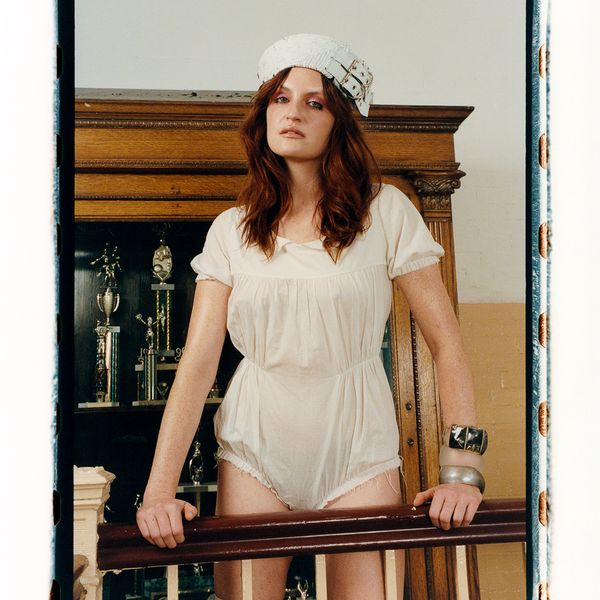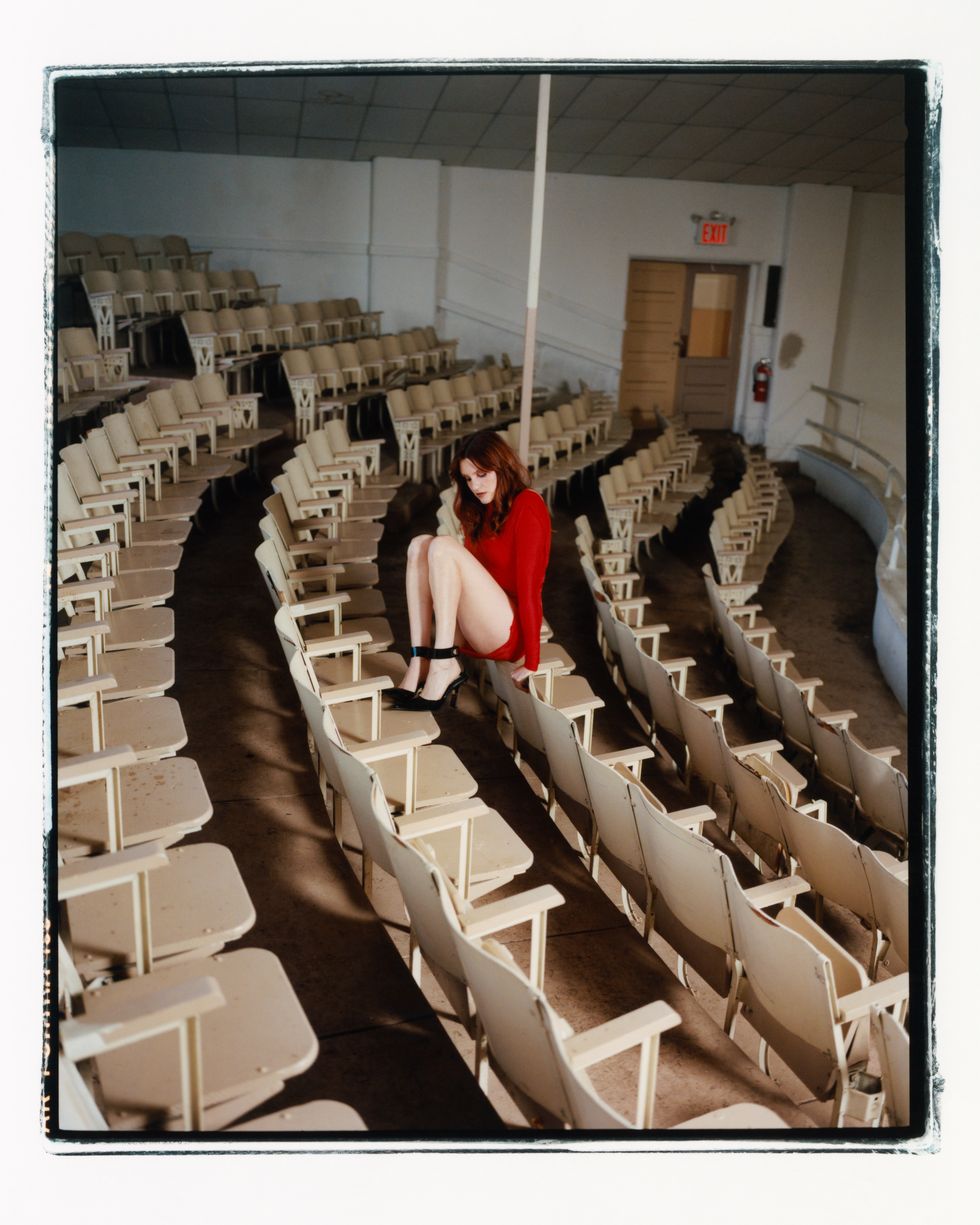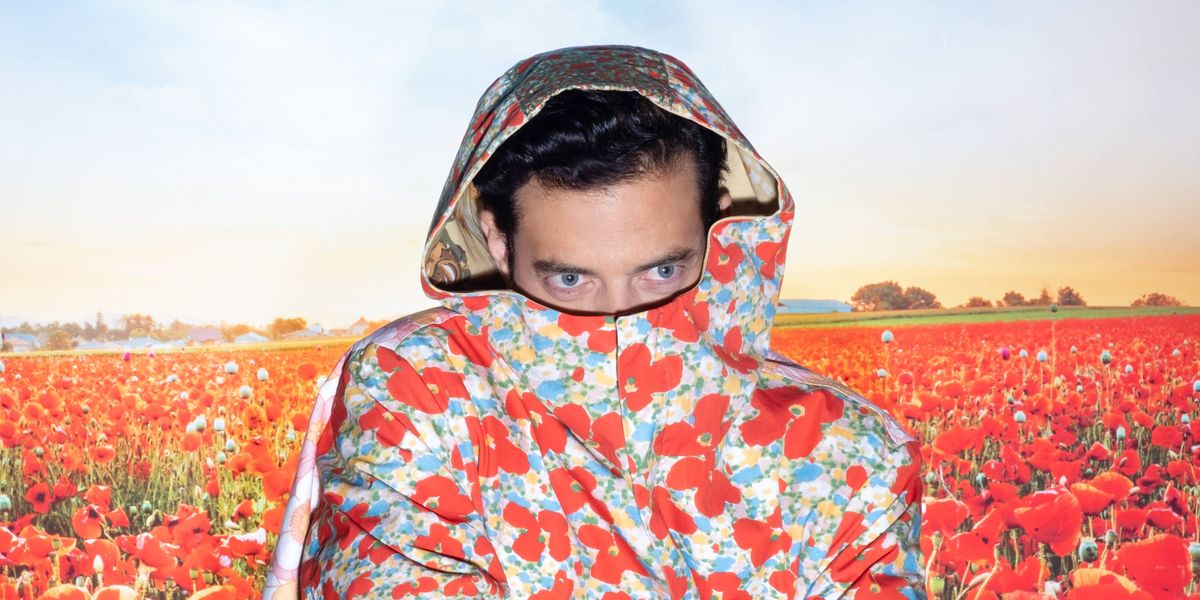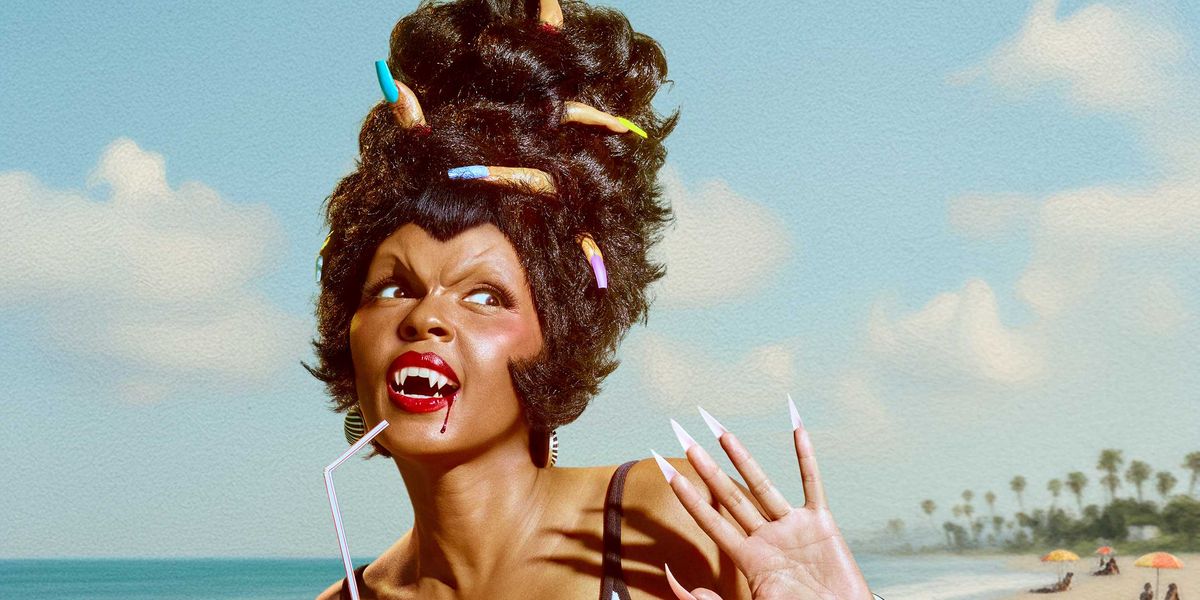
Katie Gavin Puts Herself First
Story by Justin Moran / Photography by Sophia Wilson / Styling by Emma Oleck / Hair by Marin Mullen / Makeup by Mollie Gloss
Oct 29, 2024
In May of 2015, I received a Facebook message from a stranger: “Hey qt, my name’s Katie and I’m the lead singer of a queer dark pop band called MUNA.” Full name Katie Gavin, she was cold pitching me a song her band (alongside Naomi McPherson and Josette Maskin) planned to release, called “So Special,” which would appear on MUNA’s debut album. “It’s a sad dance anthem about getting slut-shamed and getting drunk,” she wrote in her note. “But at the end of the day, it’s kind of functioned as a reminder that sometimes we have to pretend we feel valuable until we believe we are again.”
A decade and three albums later, MUNA has gone on to become a defining force in pop music, blazing a trail for the queer renaissance we’re finally witnessing at the top of the charts. Through it all, Gavin was quietly writing and recording material that would eventually make up her breakout solo album, What a Relief, out now. Much like in “So Special,” its themes explore the inner tension between good and bad — Gavin’s desire and worthiness of being loved, despite turbulent life decisions and the harsh reality that humans will never be perfect.

Bra: Vaquera, Skirt: Iseder, Headpiece: Sideara, Shoes: Ben Doctor, Belt and glove: Stylist's own
On album highlight “Casual Drug Use,” Gavin forgives herself for reckless behavior, singing, “I’m not gonna lose it ‘cause we’re not going to get wherever we’re going right this moment.” Elsewhere she lets the mess spill out further, whether it be with her insatiable and at times contradictory need for a lover (“I Want It All”) or the way she holds onto and craves the flavor of an ex (“Aftertaste”). On “Inconsolable,” she sings about the emotional impact of generational trauma, and on “Sketches” she outlines how her disillusionment towards love grows the deeper she gets into relationships. “Oh, what a relief to know that some of this was my fault,” Gavin sings on “Keep Walking,” taking partial responsibility for her actions. “I am not a victim after all.”
Now 31, Gavin offers an extremely human retelling of her twenties wrapped in folk production that sounds familiar and lived in. Where MUNA allows her the space to step into more of an alter ego (a “queer superhero” as Gavin describes it), What a Relief is the artist at her most vulnerable and true to self. Below, I called her up from her home in Los Angeles, where she took me for a walk to the river over video chat and reflected on the past 10 years of making music. “I previously would have described myself as a people pleaser,” she says. “But I have this awareness now that I will make the sacrifices that I need to make for my art, which is kind of badass.”
Wait is it the Justin?
It’s me!
Oh my God, hi.
How are you?
I'm good. Well that's kind of a lie, but I'm excited to be talking to you. I'm going to take you on a walk.
Everything is crazy, but I’m also excited to talk to you. My favorite MUNA lore is the Facebook message you sent me back in 2015.
It's my favorite lore, too. I bet we could find it. I was like, so desperate.
It’s funny looking back considering how successful MUNA has become. You asked me to premiere “So Special.”
Yeah, it was “So Special.”
Pretty crazy.
I know.
Did you ever expect you’d have the career you’ve had over the past 10 years?
I really liked being our PR person. We had this feeling of, We are cool and people will like us, but we need to get our foot in the door. We had a couple of songs at the time that we had stockpiled from a year of working and figuring out our sound. And I think “So Special” was the first or second one that we were premiering out the gate. We just knew we needed someone to take a chance on us and it ended up being another queer kid who, I mean, look at you, honey–
Look at us both!
I know, it's really sweet. And I know that’s a thing that happens, talking to people who are a little older than me in other realms of arts and entertainment. You see your friends and the people that you were roughing it with flourish and it just feels really surreal.

Dress: Margarida Feijão, Headpiece: Sideara, Shoes: Melitta Baumeister, Gloves: Stylist's own
Yeah, I do think the world has a way of making you find the people you're supposed to find, more magically and easily than maybe we would have thought growing up.
I like that thought. I'm walking to this spot on the river that I like. I find it easier to talk to people while I'm outside in the world.
I feel that. Where's the spot on the river? Do you go there often?
Yeah, I go to the LA River all the time. And also when I'm touring, whenever I can, because I take my roller blades on tour, I will find whatever river I'm closest to. Obviously, the LA River is toxic and will give you cancer, but I still like it and I'm on it a lot and walking around it. The area that I live in is right off the river. I was thinking about how the first time I had a group of songs that comprised the solo record, like the first time I realized this is a record, I remember going on this loop with those songs and listening to the whole thing together and just being like, “Damn.”
Was the plan to always eventually make a solo album, or were you working on things for fun and it became a project on its own?
I think it's more the latter. I really do feel better suited as a person to being in a band. Even during this project and the promo cycle, Naomi and Jo are sorely missed. But I felt like I owed it to myself as a songwriter, like I have these other songs that I love that don't fit into my main project. And I think we're at a point in our careers now, we've been a band for 10 years, where there's more space and freedom for us each to explore those things. But yeah, I knew while we were making our third [MUNA] record that I was going to put out a solo record. We initially thought that it was going to come out before that record, but then, I don't know, it just worked out a different way.
What is the creative process for you as a solo artist versus working with the band? It’s fun now listening to this album and then figuring out what elements of MUNA are more purely Katie Gavin than others. But is it even that black and white?
It’s a really hard question, honestly. I write most of the MUNA songs, so it's not different in that way. But if a song really speaks to Naomi and Jo in addition to me, like if they connect with something, the effect is that MUNA songs feel bigger in scale. I love that about the project. Especially at this point, we've become alter egos. [MUNA] feels like the queer superhero project. A lot of these songs on this record, I hope that they'll connect with a lot of people. But lyrically when you're listening to them, it's very clear that it's just me, Katie Gavin the person, talking about my day-to-day life and things I experience, Home on the Range style, you know?

Bodysuit: Archive Maison Margiela, Hat: Vaquera, Shoes: Ben Doctor, Bracelets: SkankChic
The experience of MUNA definitely feels fuller. So it's really cool to hear songs from you that are more vulnerable, even in the way they're produced. How do you tap into something so honest and specific with your songwriting? One of the big topics on this album is love, but you frame it in ways I’ve never heard or thought about. And still, it somehow resonates deeply.
I don't think it's something that I do on purpose. It's a gift and a curse. I'm neurodivergent and my brain just works a little differently. I have several diagnoses that affect the way I process relationships and things that happen in my life, and I think that comes out in songwriting. It has always been a space where I have tried to keep it really sacred in terms of telling myself that I can say whatever I need to say. I seem to not have the same filter that a lot of people have about things that seem vulnerable. It's a common experience for me that people will be like, “Thank you so much for sharing, that was so brave and vulnerable. And I'm like, “What?” I'm not thinking about it. It's almost like it's compulsive. It's not a moral high standing, I just don’t have a choice.
Would you say it's easier or scarier to tell these stories alone as Katie Gavin?
I think it is scarier, I've been talking to some friends about it. I realized that in MUNA, when we have something coming out, I might have worries about how it's going to be perceived, but I have such a consistent belief that Naomi and Jo are amazing musicians and the coolest fucking people. So if people don't like it, there's kind of this built-in pad of, Fuck them, they're wrong because these two are the best and they like me, so I must be the best too. But doing it on your own, it just feels like I don't have that safety net. That being said, I didn't make this record on my own. A lot of the people who worked on it, I feel so lucky to get to work with. So I still have some of that in my back pocket.
Tell me more about that collaborative process. Were you working over a long period of time with multiple friends? Or was it more focused, like you and a few people from start to finish?
It was kind of a clusterfuck. Every time I tell the story, I try to make sure all the iterations of people who worked on the record are named. First version was my friend Eric Radloff and my friend Scott Heiner. Scott was the OG drummer in MUNA, and they started working on arrangements for these songs in 2020 during the pandemic. We recorded 10 demos over two weeks at a studio in Silver Lake and that was what I showed to Phoebe [Bridgers] when we signed to Saddest Factory Records. I said, “I'm also working on this other record,” and she was like, “Cool, I want to put this out as well, but I think that my producer, Tony Berg, would be good to touch these songs and spruce them up.” We tried to go in with him and have him edit the recordings that we already had, and it just wasn't really working for any of us.
So I kind of just put it down. When the MUNA record came out, I was touring all the time and it was doing very well, so I just put this on the back burner. And then my friend Amber Bain, her project is The Japanese House, she's been my number one fan and cheerleader and supporter. She was always like, “I really love these songs, don't let it go. I would be down to work on them with you.” I also had written more songs that were more of the solo record vibe. So I worked on some with Amber and then I had this dilemma of, I have 10 songs that sound one way and I have five songs that sound another way. How do I make this a cohesive record?
And in the end, I decided to record everything from scratch with Tony and a bunch of other musicians. But at that point, it was everybody's contribution. I knew which songs were the strongest. I knew what parts from what arrangements we really needed to keep. I just had a clearer idea, I had lived with the songs for such a long time. Also, having that successful of a record cycle with MUNA gave me a lot of confidence that I didn't have before. But the recording process was super different than a MUNA record because in MUNA we were doing a lot of programming and not a lot of live recording with the exception of Naomi playing synth and Jo playing guitar. But we just brought in a crew of really talented live players.
It's so funny, I'm sure people will be like, “So you just had MUNA play on the album? How is it not MUNA?” But Geo [Botelho], who's our bassist, played on some of the songs. And then this girl, Nana [Adjoa], who was working in the studio. She's a multi-instrumentalist and she understood the record really well. I'm excited to be working on arrangements that are really stripped back with just her and I. Then Sara and Sean Watkins from Nickel Creek played on a couple of songs. Eric [Radloff], my OG homie, came back to the studio to do a couple of songs with me. He's the guy singing on “The Baton,” which was really special because since we started working on that he’s had a baby girl.

Bra: Vaquera, Skirt: Iseder, Headpiece: Sideara, Shoes: Ben Doctor, Belt and glove: Stylist's own
“The Baton” is such a sweet song.
Thank you.
I also like “Casual Drug Use,” it’s probably my favorite. I’ve developed my own personal meaning, but what is the actual story behind the song?
I wrote that in 2016, it was post-breakup with Naomi. I was living in somebody's back house in Glendale and I was ingesting various substances. I wrote it about this day trip that I took with a friend of mine. I think we were both going through a lot at the time, so I was trying to express the calm that you can sometimes get when you have a hangover and you're watching a movie with a friend. It's like, we're not being the best versions of ourselves right now, but we're not going to be smited by God. It's lowkey fine and we can just hang out. At the time, I was trying to convince myself of that because I felt bad about my behavior.
What's nice is you're acknowledging the bad behavior, but it's not the end of the world. It won’t be fixed right now, so just let yourself have that moment. So 2016, it sounds like these songs were written over a long period of time.
MUNA is more broken down into specific chapters of my life. But I think this falls in line with the trope of a debut album, which is that it spans a much larger period of time from somebody and it gives a wider picture of who they are and what they think about.
Collectively, what do you think this album says about you?
Oh, I have no idea. I hope that it portrays a consideration and gentleness. It seems like people are really picking up on the fact that there's a lot of gray area on the record and being able to sit with being somebody who makes mistakes and possibly does harm and still being worthy of love. That sounds so cheesy, but it always is cheesy when you are distilling it in that way.

Dress: Balenciaga, Shoes: Versace FAS
How did you come up with the name, What a Relief?
It's funny you ask me that question because, right after that answer, I'm kind of like, maybe that's part of it. Oh, what a relief that it’s actually fun. I honestly thought it was a funny phrase. The gag for me was that I'm 31 and I'm putting out a debut record I just thought was fun. Whatever relief, I got it out the door in the nick of time before the pop culture patriarchy puts me out to pasture.
I'm also 30 and don't you think that you needed your 20s to know what you wanted to say? Like, the expectation for us to have full clarity of self at age 21 is so unreasonable.
Well, that’s the real gag. I think women slash femmes and gay men both deal with this in different ways. We're expected to be hitting our peak when we're perceived to be the most fuckable or something messed up like that. And I know that I really did need all that time, especially to make something on my own. Again, I think that's part of what was so amazing about starting a band when we were that young — we could help each other figure out what we really wanted to say. But we were figuring out so much, you know, and that changed so much since then.
What do you think you learned about yourself through making this album?
I think in making a record on your own, you have to sometimes make choices that you know are gonna be disappointing or confusing to other people. I wasn't really sure that I was going to be up for that because I do want to make everybody else happy. But I was able to, at the end of the day, live through putting my art first and putting the project first and doing what I felt was best, even if not everyone agreed with me. And that was a really important lesson for me and changed the way I see myself.
Changed the way you see yourself in terms of what?
In terms of what I'm capable of. I think I previously would have described myself as a people pleaser — I have those tendencies. But I have this awareness now that I will make the sacrifices that I need to make for my art, which is kind of badass.
It really is. This was a quick chat and we’re overdue for a full life catch-up. But congratulations on this album. I always tell everyone that I think you’re the best songwriter in the industry. It’s been such a treat talking to you and so cool to watch you grow over the past 10 years.
Thank you, Justin. It really means so much to me. It’s good to see you.
Good to see you, too.

Bra: Vaquera, Skirt: Iseder, Headpiece: Sideara, Shoes: Ben Doctor, Belt and glove: Stylist's own
I will make the sacrifices that I need to make for my art, which is kind of badass.
Photography: Sophia Wilson
Styling: Emma Oleck
Hair: Marin Mullen
Makeup: Mollie Gloss
Creative assistant: Raqeul Michel
Lighting tech: Josh Jiminez
Styling intern: Kendall Crider
Editor-in-chief: Justin Moran
Managing editor: Matt Wille
Editorial producer: Angelina Cantú
Music editor: Erica Campbell
Story: Justin Moran
MORE ON PAPER
Entertainment
Rami Malek Is Certifiably Unserious
Story by Joan Summers / Photography by Adam Powell
Story by Joan Summers / Photography by Adam Powell
14 November
Music
Janelle Monáe, HalloQueen
Story by Ivan Guzman / Photography by Pol Kurucz/ Styling by Alexandra Mandelkorn/ Hair by Nikki Nelms/ Makeup by Sasha Glasser/ Nails by Juan Alvear/ Set design by Krystall Schott
Story by Ivan Guzman / Photography by Pol Kurucz/ Styling by Alexandra Mandelkorn/ Hair by Nikki Nelms/ Makeup by Sasha Glasser/ Nails by Juan Alvear/ Set design by Krystall Schott
27 October
Music
You Don’t Move Cardi B
Story by Erica Campbell / Photography by Jora Frantzis / Styling by Kollin Carter/ Hair by Tokyo Stylez/ Makeup by Erika LaPearl/ Nails by Coca Nguyen/ Set design by Allegra Peyton
Story by Erica Campbell / Photography by Jora Frantzis / Styling by Kollin Carter/ Hair by Tokyo Stylez/ Makeup by Erika LaPearl/ Nails by Coca Nguyen/ Set design by Allegra Peyton
14 October
Entertainment
Matthew McConaughey Found His Rhythm
Story by Joan Summers / Photography by Greg Swales / Styling by Angelina Cantu / Grooming by Kara Yoshimoto Bua
Story by Joan Summers / Photography by Greg Swales / Styling by Angelina Cantu / Grooming by Kara Yoshimoto Bua
30 September
Music
Demi Lovato Is No Joke
Story by Ivan Guzman / Photography by Jason Renaud / Styling by Chris Horan/ Makeup by Loftjet / Set design by Allegra Peyton
Story by Ivan Guzman / Photography by Jason Renaud / Styling by Chris Horan/ Makeup by Loftjet / Set design by Allegra Peyton
15 September




